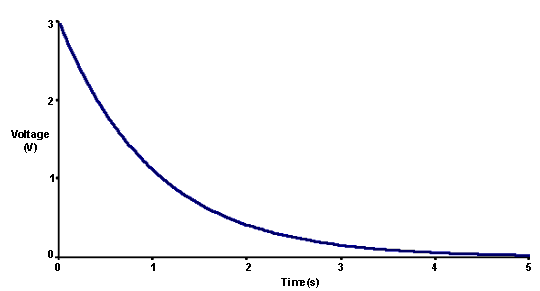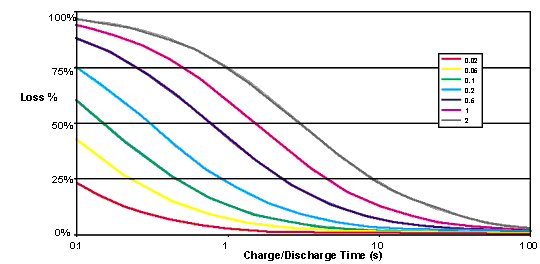An analogy can be used to better describe the
concept of time
constant.
Consider a bucket full of water elevated to some
height, say h. This height is equivalent to the
voltage V on our capacitor.
We can consider a big bucket (with big diameter)
with water at height h as having a certain capacity,
equivalent to the energy stored by our capacitor
whose capacitance is C. A smaller bucket (with
smaller diameter) with water still at height h
will have a smaller capacity. The energy stored
in our capacitor is equal to
E =1/2 CV 2
If the bucket has a hole in it, then it will
leak and the water level will decrease from height
h to zero. If the hole is big, then the leak will
be quick. If the hole is small then the leak will
be slow. The bigger the hole, the smaller the resistance
R of our capacitor. The smaller the hole, the bigger
the R. Thus the smaller the R, the quicker the
voltage drop and hence the energy decrease.
If we have a bigger capacity bucket (proportional
to our capacitance C), but the height h is as before,
then it will take longer for the height to decrease
to zero, given a constant sized hole. Thus the
smaller the C, the quicker the voltage drop and
hence the energy decrease.
The rate at which the height (voltage) decreases
depends on the product of R and C and is called
a time constant, and it is normally given a symbol
t.
t = RC
Figure A shows how the voltage of a capacitor
drops from an initial voltage of 3.0 V with a time
constant t of 1 second. The shape of this graph
does not change. If the time constant doubles,
then the scale doubles.
Figure A: Time Constant of 1 second

Within a period of one time constant, t, the
voltage has dropped to 1/3 of its initial value.
Therefore the energy has dropped to 1/9 of its
initial value, 89% of the capacitor's energy has
been used and 11 % is still stored in the capacitor.
Conventionally, a capacitor is discharged to 1/2
of its initial voltage, retaining 1/4 of its initial
energy, thereby utilising 75%.
This raises the question of efficiency. The implication
of the above statement is that there is no energy
wasted. This is not true. Energy is wasted in the
resistor (it becomes heat, and thus heats the capacitor).
How much energy is wasted in the capacitor and
how much is delivered to the load (the place the
energy is needed) thus depends on the ratio of
the resistance of the capacitor, R, to the resistance
of the load. The smaller the R, the less the loss
and the greater the efficiency.
If it is desired to discharge the capacitor to
half of its initial voltage, thereby utilising
75% of the stored energy, then the energy lost
on discharge can be determined for different discharge
times. If you discharge slowly, then the resistance
of the load must be quite high, so that the resistance
R can be relatively small. Thus as discharge gets
faster, the resistance R becomes more important,
generating losses. For very fast discharges, there
are very high losses. However, as the time constant
t decreases, so does R, and hence losses become
smaller. This effect is shown in Figure B.
Figure B: Losses for RC time constants
from 0.02 to 2 seconds

CAP-XX produces supercapacitors with time constants
from 0.001 seconds to 5 seconds. Competitors' products
which can operate at voltages similar to those
for CAP-XX are currently limited to time constants
over 1 second. CAP-XX thus has a distinct competitive
advantage for applications in which discharge is
required in times less than 30 seconds. Other devices
will have high losses that will heat and therefore
damage the supercapacitor.
